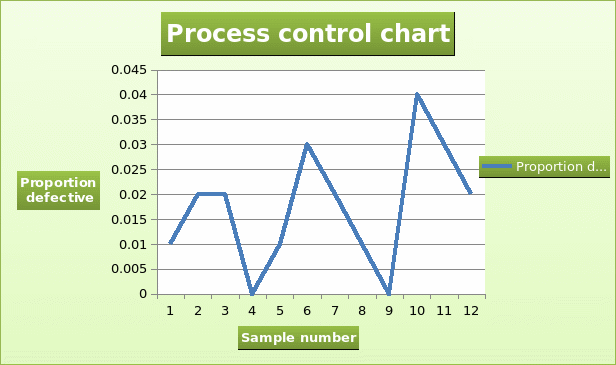Typing pool
Part a
This section will entail the construction of process control limits for a typing pool. The first stage entails computing the sample proportion for each of the values in the sample. The value is arrived at by dividing the number of defective items by the sample size. The sample proportion is presented in the table below.
The second step entails calculating the average of the sample proportion. The average is arrived at by dividing the total number of defective by the total number of observations in the sample. The calculations are shown below.
ṗ = 84 / 4800 or 0.21 / 12
= 0.0175
The third step entails calculating the standard deviation of the sample proportion. The formula for calculating the standard deviation is presented below.
Sp = √ [ṗ (1 – ṗ)] / n
= √ [0.0175(1 – 0.0175)] / 400
= √0.000042984375
= 0.006556
Upper control limit = p + 3 sp
= 0.0175 + (3 * 0.006556)
= 0.0175 + 0.019669
= 0.03717
Lower control limit = p – 3 sp
= 0.0175 – (3 * 0.006556)
= 0.0175 – 0.019669
= -0.002169
Therefore, the control limit for the p-chart lies between (0.002169) and 0.03717. This implies that if all the values of sample proportion fall within the range, then the process is considered to be in control. However, if some values lie outside the p-chart range, then the process is considered to be out of control.
P –control chart
The graph presented below shows the process control chart for the typing pool.

Thus, it can be noted that only one point (0.04) lies outside the control limit. It lies above the upper control limit. Thus, it can be concluded that the process is not in control. This implies a sample of 12 from 400 letters will yield only one defective.
Part b
The sample proportion for a sample of six from 400 letters is calculated as shown below.
ṗ = 6 / 400
= 0.015
From the previous calculations, the upper control limit was 0.03717 while the lower control limit was (0.002169). Thus, a value of 0.015 falls within the upper and lower control limits. This implies that the process will be in control when a sample of 6 letters is picked.
Question 2: Robin Hood Bank
This section will entail calculating control limits for the x-bar and R-chart for the bank.
Part a: control limits for x-bar and R-charts
Average daily demand deposit balance = $109 million (It represents the sample of all the sample averages.)
Average range = $15 million (It represents the average of all the sample ranges.)
X – Bar
Control limit (CL) = 109 million
The value of A2 is read from a table. A section of the table for A2 is presented below.
Therefore, from the table, the value of A2 is 0.483.
Upper control limit (UCL) = 109 + 0.483 (15)
= 116.245 million
Lower control limit (LCL) = 109 – 0.483 (15)
= 101.755 million
Based on the calculation, the control limit for the x-bar lies between 101.755 million and 116.245 million. Thus, values that lie outside the x-bar control limit will make the entire process be out of control.
R – Chart
Control limit = 15
The values of D3 and D4 are read from a predetermined table. A section of the table is presented below.
Thus, the value of D3 and D4 are 0 and 2.004 respectively.
Upper control limit = 0 (15)
= 0
Lower control limit = 2.004 (15)
= 30.06 million
Based on the calculation, the control limit for the R-chart lies between 0 million and 30.06 million. Values that lie outside the range make the whole process to be out of control.
Part b: average and range
The calculation for the average demand deposits for the past six days is presented below.
= (110 + 102 + 96 + 87 + 115 + 106) / 6
= 616 / 6
= 102.67 million
The calculation for the range of the demand deposits for the past six days is presented below.
= 115 million – 87 million
= 28 million
The average of the sample of the past six days is 102.67 million. It lies within the upper and lower control limit for the X-bar. Further, the range of the sample collected in the past six days is 28 million. The range also lies within the upper and lower control limit for the R-chart. Thus, the management needs to continue with the production process because there is no alert for an assignable cause.
Question 3
α = 0.1 (all values are corrected to 2 decimal places)
α = 0.3
Thus, exponential smoothing with α = 0.3 provide better results than α = 0.1.